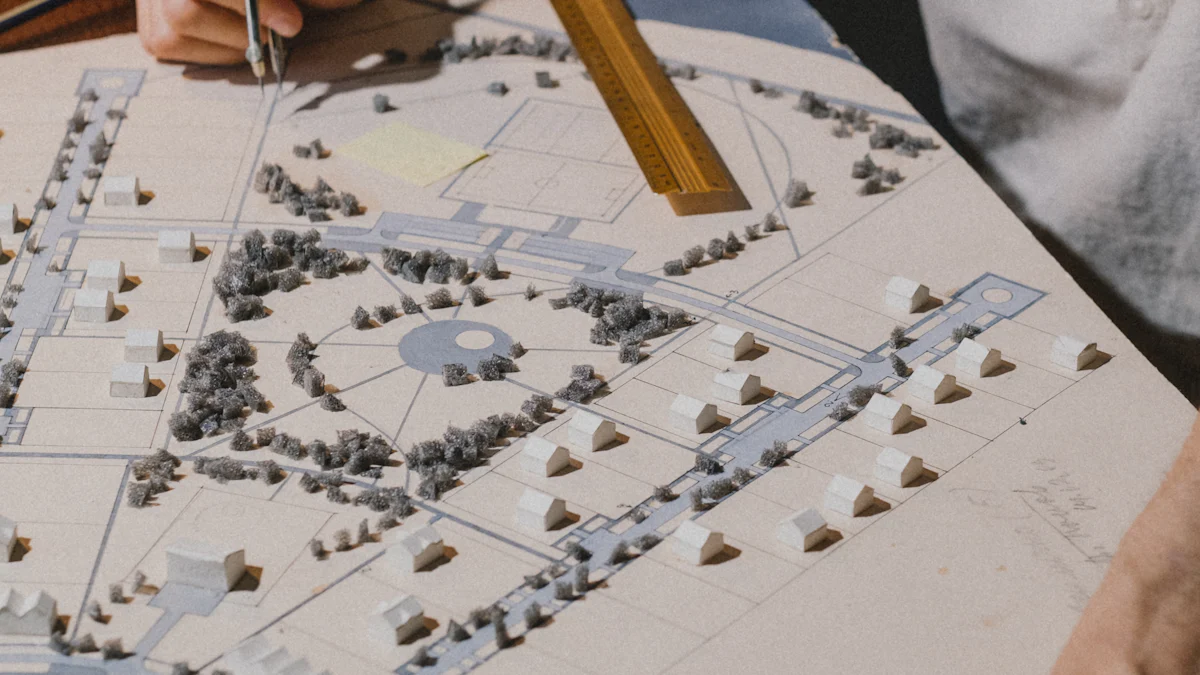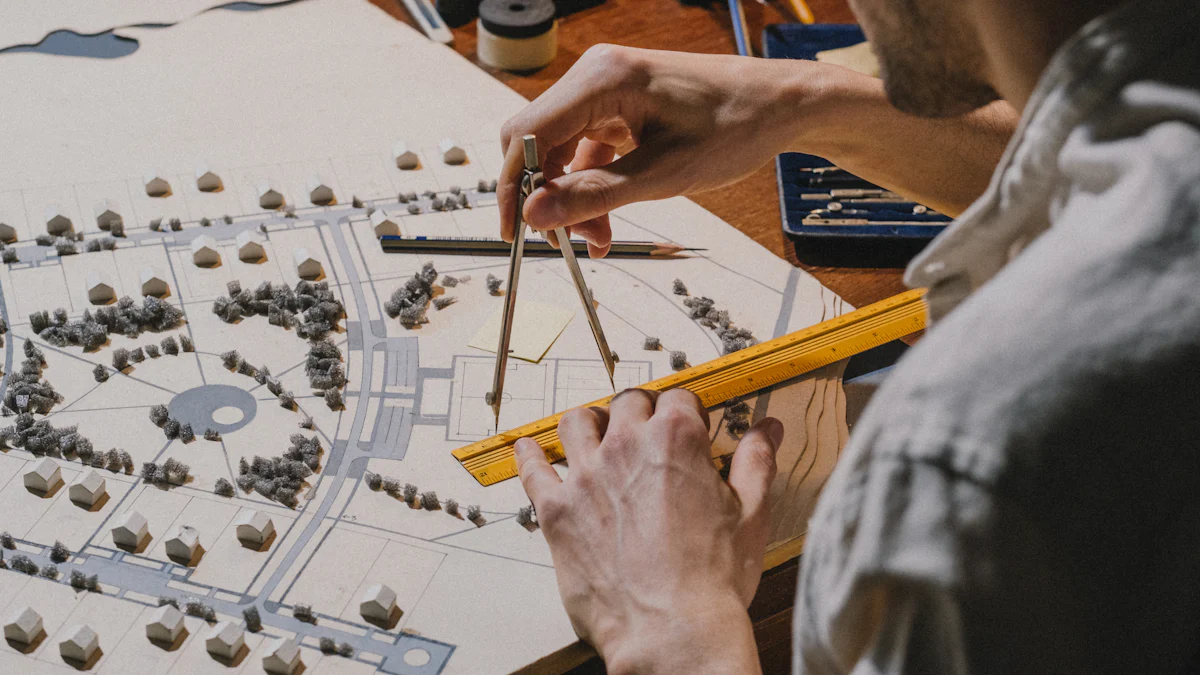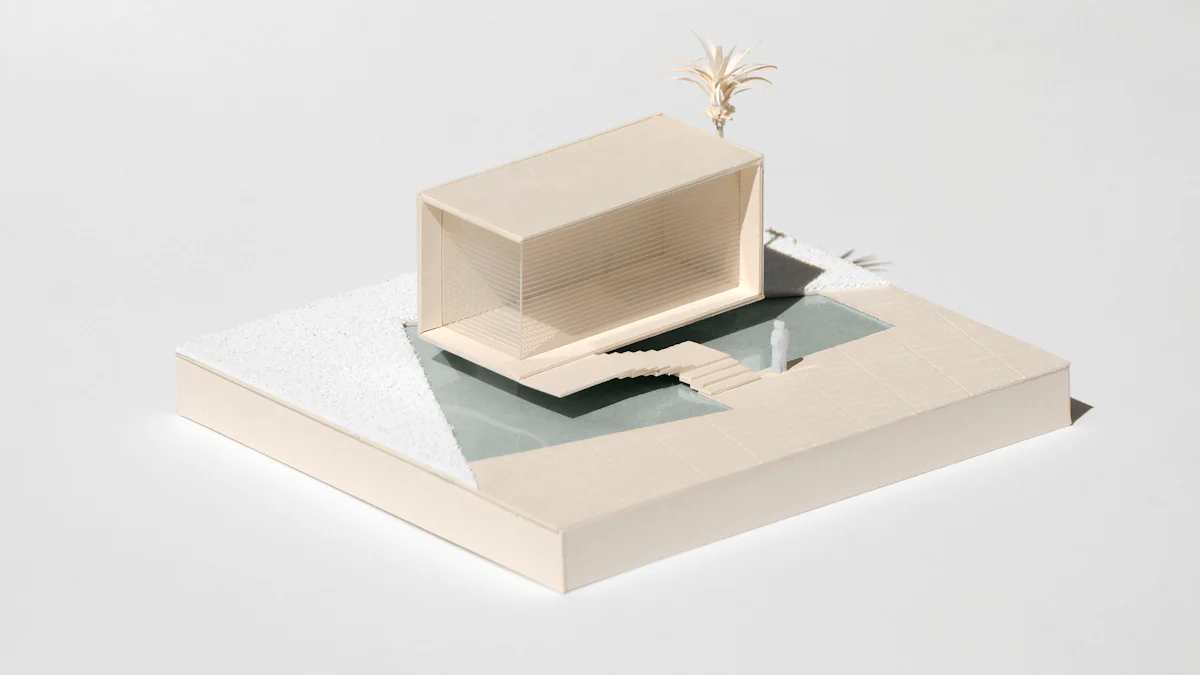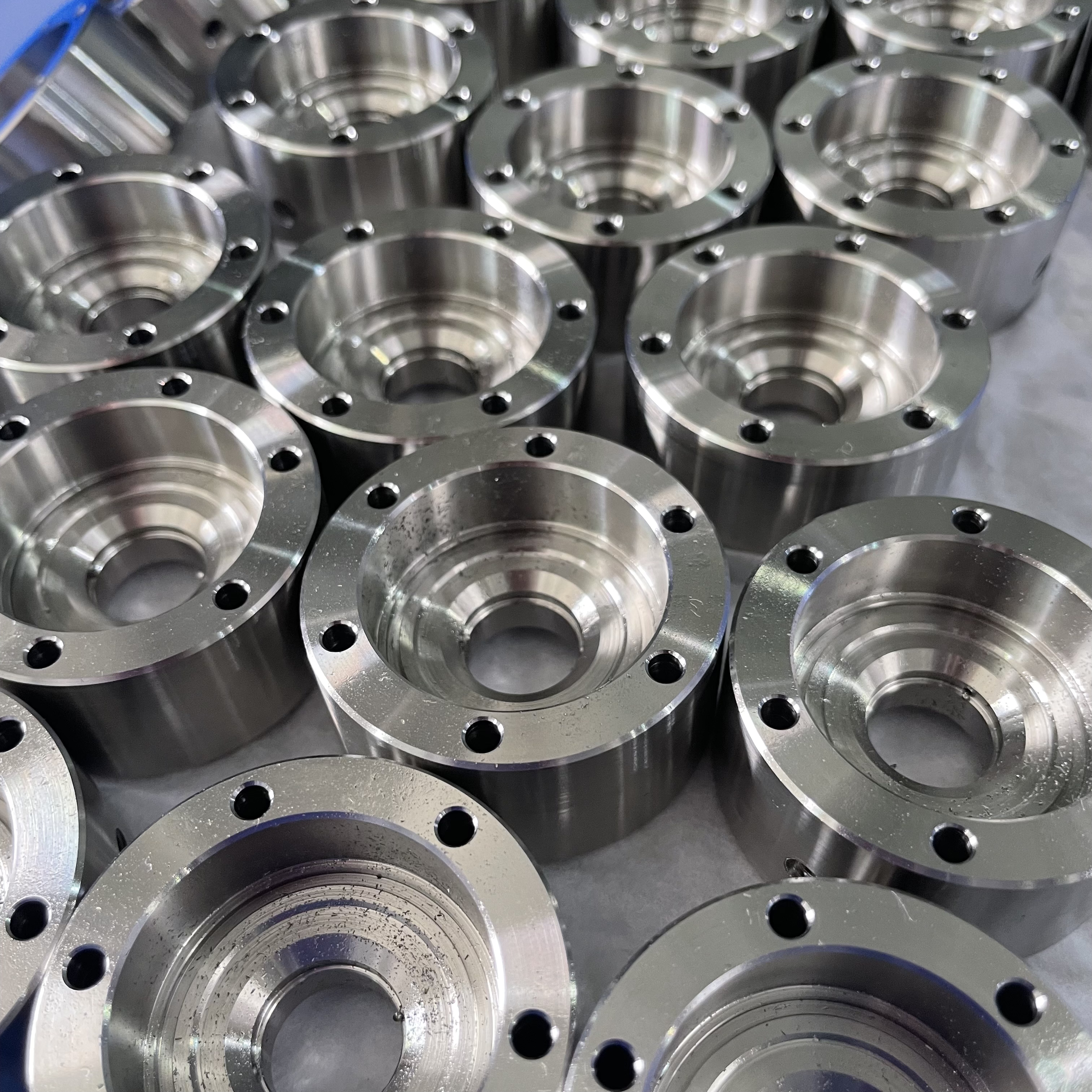CNC Solutions for Architectural Models and Designs

Imagine turning your most intricate architectural designs into reality with unmatched precision. CNC machining has revolutionized how you can create models and prototypes. Since its rise in the 1990s, this technology has bridged the gap between digital designs and physical structures. It eliminates the need for manual molds, speeding up production while maintaining accuracy. Whether you're crafting a custom window frame for a historic home or testing a bold new concept, CNC machining ensures every detail is perfect. With this tool, you can explore creative possibilities like never before.
Key Takeaways
CNC machines help turn digital designs into real models easily.
This tool makes model-making faster and keeps parts accurate.
CNC reduces wasted materials and saves money on labor costs.
Combining CNC with CAD and CAM software improves teamwork and flow.
CNC lets architects try new ideas and create detailed designs.
Understanding CNC Machining in Architecture
What is CNC Machining?
CNC machining stands for Computer Numerical Control machining. It’s a process where computers control machines to cut, carve, or shape materials into precise designs. Think of it as a bridge between your digital blueprints and physical models. You upload your design into the system, and the machine takes care of the rest. It’s like having a skilled craftsman who never makes mistakes. This technology is widely used in industries like manufacturing, but its role in architecture is truly transformative.
With CNC machining, you can create intricate architectural models, custom furniture, or even structural components. The best part? It’s fast, accurate, and consistent. Whether you’re working with wood, metal, or plastic, this process ensures your designs come to life exactly as you imagined.
Relevance of CNC Technology in Architectural Design
CNC technology has become a game-changer for architects. Why? Because it simplifies complex tasks and opens up new creative possibilities. For example:
You can produce detailed prototypes to visualize and refine your designs.
It allows you to create lightweight yet strong materials, perfect for innovative structures.
Physical models made with CNC technology help you communicate ideas more effectively with clients.
This technology also ensures consistency. If you’re working on a large project, every piece will match perfectly. No more worrying about slight variations that could throw off your design. Plus, it’s incredibly efficient, saving you time and resources.
The Role of CNC in Modern Architectural Practices
In today’s fast-paced world, CNC technology plays a vital role in modern architecture. It’s not just about creating models; it’s about transforming how you approach design and construction. Imagine crafting custom light fixtures, decorative columns, or even unique staircases with ease. CNC machining makes all of this possible.
Architectural model-making has also become faster and more precise. You can produce detailed scale models in hours instead of days. Need custom doors, windows, or even ornamental gates? CNC technology ensures they’re tailored to your exact specifications. It’s a tool that empowers you to push boundaries and bring your boldest ideas to life.
Benefits of CNC Machining for Architectural Models

Precision and Accuracy in Design
When it comes to architectural models, precision is everything. Even the smallest error can disrupt the assembly or ruin the overall look of your design. CNC machining eliminates these worries. Its computer-controlled process ensures every cut and carve matches your exact specifications. This level of accuracy is impossible to achieve with manual methods.
You can rely on CNC machining to meet the tight tolerances required for custom architectural elements like window frames or doors. The technology minimizes errors, so you get flawless results every time. Whether you're working on a detailed façade or a complex structural component, CNC machining guarantees the precision you need to bring your vision to life.
Speed and Efficiency in Model Creation
Time is a precious resource in architecture. Traditional methods of creating models can take days or even weeks. CNC machining changes the game by streamlining the entire process. You can go from a digital design to a physical model in a fraction of the time.
Here’s how it boosts efficiency:
It automates the production process, saving you hours of manual labor.
The precision of CNC machining reduces errors, so you don’t waste time fixing mistakes.
It ensures consistency, so every piece fits perfectly without adjustments.
With CNC technology, you can complete projects faster and meet tight deadlines without compromising quality. This speed doesn’t just save time—it also helps you stay ahead in a competitive industry.
Consistency and Scalability for Large Projects
Large-scale projects often involve creating multiple identical components. Achieving consistency manually can be a nightmare. CNC machining solves this problem effortlessly. Once you upload your design, the machine produces identical pieces with unmatched accuracy.
This consistency is invaluable for large projects. Whether you’re crafting hundreds of decorative panels or structural elements, every piece will match perfectly. CNC machining also scales easily. Need to increase production? The process adapts without sacrificing quality. It’s a reliable solution for architects tackling ambitious designs.
Cost-Effectiveness in Prototyping and Production
Let’s face it—budget constraints are always a concern in architectural projects. Whether you’re working on a small-scale prototype or a large production run, keeping costs under control is crucial. That’s where CNC machining shines. It’s not just about precision and speed; it’s also a smart choice for your wallet.
First, CNC machining reduces material waste. Traditional methods often involve trial and error, which can lead to wasted resources. With CNC, the process is so precise that you only use what’s necessary. This efficiency saves you money, especially when working with expensive materials like hardwood or metal.
Second, it minimizes labor costs. Think about how much time and effort manual crafting requires. CNC machines handle the heavy lifting, so you don’t need a large team to produce high-quality results. This automation means you can allocate your budget to other parts of your project.
Another big advantage is its ability to create prototypes quickly and affordably. Need to test a design before full production? CNC machining lets you create detailed architectural models without breaking the bank. You can refine your ideas and avoid costly mistakes down the line.
Finally, CNC machining scales beautifully. Whether you need one prototype or hundreds of identical components, the cost per unit decreases as production increases. This scalability makes it perfect for both small and large projects.
In short, CNC machining helps you save money while delivering top-notch results. It’s a win-win for architects looking to balance quality and cost in their designs.
Material Considerations for CNC Architectural Projects
Commonly Used Materials
When working on architectural projects, the material you choose can make or break your design. CNC machining works with a wide range of materials, each offering unique benefits. Here’s a quick look at some popular options:
Material | Key Properties | Common Applications |
|---|---|---|
ABS | Good physical properties, easy to machine, low cost | Pipes, fittings, prototypes, 3D building |
PVC | Sturdy, chemical and fire resistant, low cost | Pipes, medical devices, automotive interiors |
Acrylic | High strength, UV tolerance, visually transparent | Architecture, LED lights, industrial applications |
Stainless Steel | High strength, corrosion resistant | Medical industry, tooling, aircraft construction |
Brass | Smooth finish, easy to machine, corrosion resistant | Sanitaryware, locks, art installations |
Titanium | High strength, corrosion resistant | Aerospace, jewelry, sculptures |
Each material serves a specific purpose. For example, acrylic is perfect for architectural models because of its transparency and strength. ABS is a go-to for prototypes, while stainless steel is ideal for structural components. Choosing the right material ensures your project meets both functional and aesthetic goals.
Durability and Aesthetic Appeal
Durability and looks matter when creating architectural designs. You want materials that last and also look great. Factors like anodizing, polishing, and powder coating can enhance both durability and appearance. For instance:
Anodizing adds a protective layer to metals, making them more resistant to wear.
Polishing gives surfaces a sleek, professional finish.
Powder coating provides a durable, colorful layer that resists chipping.
The material itself also plays a role. Stone, wood, and brick offer a rustic charm, while steel and glass create a modern vibe. Maintenance is another factor. Materials like vinyl siding and aluminum require little upkeep, while wood needs regular treatments to stay in top shape. Always consider the environment too. In humid areas, moisture-resistant materials like treated wood or composites work best.
Cost and CNC Compatibility
Your budget and the material’s compatibility with CNC machining are key factors. Before starting, you need to pick a material that’s cost-effective and easy to machine. Some materials, like ABS and PVC, are affordable and simple to work with. Others, like titanium, are pricier but offer unmatched strength and durability.
The cost of materials depends on availability, machining difficulty, and complexity. For example, hardwoods may cost more due to their density and the tools required to cut them. By balancing cost, machinability, and project needs, you can make smart choices that keep your project on track without overspending.
Applications of CNC Machining in Architecture

Creating Detailed Architectural Models
CNC machining makes creating detailed architectural models easier than ever. You can turn your digital designs into precise physical models with incredible accuracy. Whether you're working on a scale model of a skyscraper or a complex building façade, CNC technology ensures every detail is captured.
Here’s what makes CNC machining so effective for architectural models:
It allows you to produce rapid prototypes with high precision.
You can use various materials, like wood, acrylic, or metal, to showcase intricate three-dimensional details.
It’s perfect for creating both interior and exterior design elements.
For example, architects often use CNC machines to craft scale models of entire buildings or complexes. These models help you visualize your designs and communicate ideas to clients or stakeholders. The technology also ensures consistency, so every piece fits together perfectly. Whether you’re designing a modern skyscraper or a historic restoration, CNC machining brings your vision to life.
Prototyping and Design Validation
Prototyping is a crucial step in architectural projects, and CNC machining makes it seamless. You can create accurate prototypes that represent your designs perfectly. This process helps you test ideas, refine details, and avoid costly mistakes.
Here’s how CNC machining supports prototyping and design validation:
It translates CAD designs into precise physical models, ensuring your sketches are accurately represented.
You can create full-scale prototypes from materials like wood to assess functionality and aesthetics.
It minimizes misunderstandings between architects and builders by providing clear, tangible models.
Imagine presenting a prototype to your client that looks and feels like the final product. CNC machining makes this possible. It also saves time and money by reducing the need for redesigns. You can make informed decisions early in the process, ensuring your project stays on track.
Custom Interior and Exterior Design Elements
CNC machining isn’t just for models and prototypes. It’s also a game-changer for custom interior and exterior design elements. You can create unique pieces that add character and style to any space.
Some examples of custom designs you can produce include:
Metal accents for interiors, like decorative banisters or light fixtures.
Custom countertops with intricate patterns, such as Corian designs.
Unique outdoor elements, like ornamental gates or patio furniture.
Contemporary floating staircases or traditional wooden styles.
CNC machining lets you bring even the most complex ideas to life. Whether you’re designing a sleek modern interior or a rustic outdoor space, this technology ensures your creations are both functional and beautiful. It’s the perfect solution for adding a personal touch to your architectural applications.
Fabrication of Structural Components
When it comes to structural components, CNC machining is a total game-changer. You can create everything from beams to brackets with unmatched precision. This technology ensures that every piece fits perfectly, which is critical for the stability and safety of your designs.
Here’s why CNC machining works so well for structural components:
Unmatched Precision: CNC machines follow your digital designs to the letter. Whether you’re cutting steel beams or shaping wooden trusses, the results are always spot-on.
Strength and Durability: You can use materials like stainless steel, aluminum, or even composites. These materials ensure your components can handle heavy loads and harsh conditions.
Custom Designs: Need a unique shape or size? CNC machining makes it easy to create custom components that fit your project perfectly.
Tip: Always double-check your CAD designs before machining. A small error in the design can lead to big problems later.
CNC machining also speeds up the fabrication process. Traditional methods often involve manual cutting and assembly, which can take days. With CNC, you can produce structural components in hours. This efficiency helps you meet tight deadlines without sacrificing quality.
Imagine you’re working on a modern building with sleek, curved beams. CNC machining can bring those designs to life with ease. It’s not just about functionality—it’s about turning your creative vision into reality. Whether you’re building a skyscraper or a small pavilion, CNC technology ensures your structural components are both strong and stunning.
So, why settle for less? With CNC machining, you can fabricate components that are precise, durable, and tailored to your needs. It’s the perfect solution for architects who want to push boundaries and create something extraordinary.
CNC in Design and Construction Workflows
Integration with CAD and CAM Software
Integrating CNC machining with CAD (Computer-Aided Design) and CAM (Computer-Aided Manufacturing) software is a game-changer for architectural design workflows. This combination allows you to seamlessly transition from digital blueprints to physical creations. With CAD software, you can design intricate models, while CAM software translates those designs into instructions for CNC machines. The result? A streamlined process that saves time and ensures precision.
Here’s why this integration is so beneficial:
Speed: You can produce high-quality designs faster than ever.
Consistency: Every piece matches perfectly, even in large-scale projects.
Precision: CNC cutting eliminates errors, ensuring flawless results.
This setup also fosters collaboration. Designers and engineers can work on the same project in real-time, making edits without overwriting each other’s work. It’s like having a shared workspace where everyone stays on the same page. By automating the workflow, you can focus more on creativity and less on manual adjustments.
Transitioning from Design to Production
Moving from design to production can feel overwhelming, but CNC machining simplifies the process. It bridges the gap between your ideas and the final product. Here’s a step-by-step breakdown of how it works:
Step | Description |
|---|---|
Prototyping | Test your design and fix any issues before full production. |
Market Research | Gauge demand and refine your prototype based on feedback. |
Small Batch Production | Validate processes and ensure quality before scaling up. |
Preparation of Files | Double-check your CAD files for accuracy and completeness. |
DFM Analysis | Adjust designs to ensure they’re easy to manufacture. |
Manufacturing Budget | Calculate costs based on materials and production needs. |
CNC Machining Production | Use the right equipment to bring your design to life. |
Quality Inspection | Test the final product to ensure it meets your standards. |
Product Launch | Introduce your creation to the market with confidence. |
By following these steps, you can transition smoothly from concept to reality. Each stage ensures your design is ready for production, saving you time and resources.
Collaboration Between Architects and Fabricators
Collaboration is key when working on CNC machining projects. As an architect, you bring the vision, while fabricators provide the technical expertise to make it happen. This partnership ensures your designs are both practical and stunning.
CNC machining enhances this collaboration in several ways:
It allows you to create detailed and complex designs that fabricators can easily interpret.
The precision of CNC cutting ensures every piece fits perfectly, reducing errors.
Consistency across components makes large projects more manageable.
CNC modeling gives you a highly accurate representation of your design. This clarity helps builders, engineers, and other stakeholders understand your ideas better.
To get the best results, work with skilled professionals from a reputable CNC precision machine shop. Their expertise ensures your designs are executed flawlessly, bringing your vision to life.
CNC machining gives you the tools to bring your architectural ideas to life with precision and ease. It streamlines your design process, helping you create detailed, high-quality models and prototypes faster than ever. You’ll enjoy consistent results across projects, whether you’re crafting intricate furniture or experimenting with bold new designs. CNC technology also minimizes errors, so you can focus on creativity instead of corrections. From rapid prototyping to custom interior elements, it opens doors to innovation. Ready to elevate your designs? CNC solutions make it possible.
FAQ
What types of architectural projects benefit most from CNC machining?
CNC machining works well for projects requiring precision and detail. It’s perfect for creating scale models, custom design elements, and structural components. Whether you’re designing a modern skyscraper or restoring a historic building, CNC technology ensures accuracy and consistency.
Can CNC machines handle complex designs?
Absolutely! CNC machines excel at producing intricate and complex designs. They follow your CAD files with precision, allowing you to create detailed patterns, curves, and shapes that would be difficult or impossible with manual methods.
How do I choose the right material for my project?
Consider your project’s needs. For durability, go with metals like stainless steel. For aesthetics, acrylic or wood works well. Always check the material’s compatibility with CNC machining to ensure smooth production.
Tip: Discuss your material options with your CNC fabricator for expert advice.
Is CNC machining cost-effective for small projects?
Yes, CNC machining is cost-effective even for small projects. It minimizes material waste and reduces labor costs. Plus, you can create prototypes quickly, helping you refine your design without overspending.
Do I need technical expertise to use CNC machining?
Not necessarily. While understanding CAD software helps, you can collaborate with CNC professionals to bring your designs to life. They’ll handle the technical aspects, so you can focus on your creative vision.
Note: Partnering with an experienced CNC shop ensures the best results for your project.
See Also
Overcoming Obstacles to Improve CNC Prototyping Precision and Speed
Investigating CNC Machining Solutions for High-Precision Production
Streamlined CNC Machining Solutions for Accurate Manufacturing Processes
Examining CNC Technology and Precision Engineering in Electronics
Perfecting CNC Machining Techniques for Accurate Component Production
About US
Follow Us
Your prototype holds unparalleled significance, and we deeply value its uniqueness. Collaborating with you during the preparation phase for running your prototype or parts is a commitment we gladly embrace. Whether it's a single part or a complex assembly, we are dedicated to selecting the optimal tools and pathways to bring your envisioned product to life.
At Precision Fab CNC Machining, we specialize in producing parts for prototypes, short runs, and high-volume production. Our prototyping machine capabilities extend across metal, plastic, and wood machining, with welding fabrication services available to complement and finalize your prototype if required.
Address
Address: Room320 10F, Building A,Nanshan international building, Dayawan District, Huizhou, Guangdong, 516001 China
Contacts
billy@timaycnc.com

